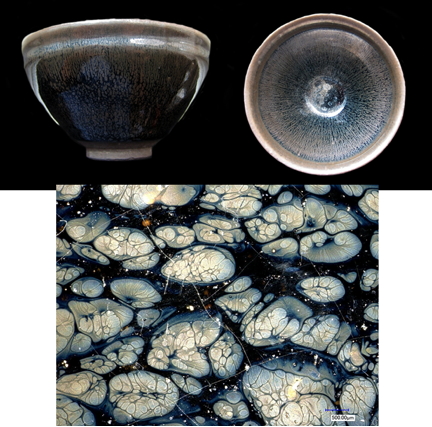Ancient Chinese Tea Bowls Hold Rare Iron Compound

Ancient Chinese tea bowls might hold the recipe for a rare form of iron oxide that scientists have had a hard time making in the lab.
Pure epsilon-phase iron oxide was unexpectedly discovered in the glaze of silvery Jian bowls made 1,000 years ago, a group of researchers announced this week.
Jian ceramic wares were created in China's Fujian Province during the Song dynasty between A.D. 960 and 1279. Today, examples can be found in museums like the Smithsonian's Freer and Sackler galleries in Washington, D.C., and the Metropolitan Museum of Art in New York. But Jian bowls even had international appeal back in their day: They were highly valued in Japan, where they were used in tea ceremonies and known as Yohen Tenmoku. [Images: Ancient Mural Tomb Discovered in China]
Beyond retaining heat (an important quality for tea-drinkers), Jian vessels were famous for their dark, lustrous glaze, which was often streaked with patterns likened to "hare's fur," "oil spots" and "partridge spots." These characteristic designs came from molten iron flux in the glaze, which flowed down the sides of the bowls and crystallized into iron oxides while cooling in the kiln, researchers say.
A team of scientists, led by Catherine Dejoie of Lawrence Berkeley National Lab in California, wanted to investigate the microstructure and local chemical composition of this type of ancient pottery. They used X-ray diffraction and electron microscopy techniques to analyze the tiny quirks on Jian pottery fragments provided by the museum of the Fujian province. Hare's fur patterns on Jian bowls, once thought to contain just the mineral hematite, were found to have small quantities of epsilon-phase iron oxide, the scientists said. The researchers also found that oil spot patterns, thought to be made of the mineral magnetite, remarkably contain large quantities of pure epsilon-phase iron oxide.
Though epsilon-phase iron oxide was first identified 80 years ago, scientists have only managed to grow tiny crystals of this material that are often contaminated with hematite. Scientists think this type of iron oxide could hold the key to better, cheaper permanent magnets used in electronics, because it has extremely persistent magnetization, high resistance to corrosion and a lack of toxicity.
"The next step will be to understand how it is possible to reproduce the quality of epsilon-phase iron oxide with modern technology," Dejoie, a scientist at Berkley Lab's Advanced Light Source and the Swiss Federal Institute of Technology in Zurich, said in a statement. "And to identify and extract synthesis conditions and other factors to obtain large crystals of pure epsilon phase."
Sign up for the Live Science daily newsletter now
Get the world’s most fascinating discoveries delivered straight to your inbox.
The findings were published online May 13 in the journal Scientific Reports.
Follow Megan Gannon on Twitter and Google+. Follow us @livescience, Facebook & Google+. Original article on Live Science.










